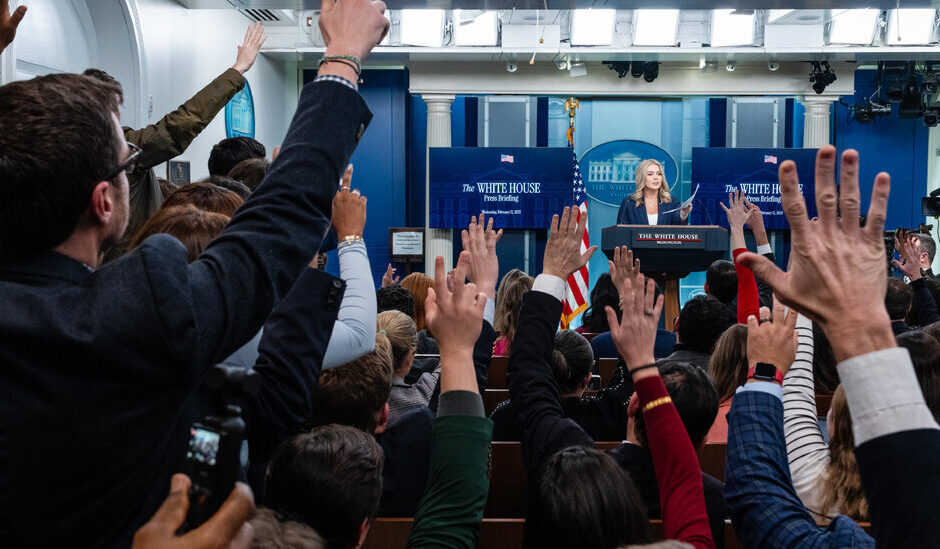Relations between the Trump administration and the White House press corps deteriorated further on Monday, as journalists pushed back on new plans to change their working arrangements in the West Wing.
The latest skirmish came as the administration said that it would consider taking control of the reporters’ seating chart in the James S. Brady Press Briefing Room, which for decades has been determined by the White House Correspondents’ Association, a group of nearly 900 journalists who report on the president and his administration.
Where a reporter sits for the televised briefings is a symbolic matter — it points to the perceived importance of a specific news outlet — and a practical one, too. Journalists in the front rows typically get more of their questions addressed by the press secretary during briefings.
In a note to members, the board of the correspondents’ association accused Trump officials of seeking “to exert pressure on journalists over coverage they disagree with.”
“The White House should abandon this wrongheaded effort and show the American people they’re not afraid to explain their policies and field questions from an independent media free from government control,” the board wrote.
A change to the seating chart would amount to another encroachment by President Trump’s aides into the day-to-day procedures of the journalists who cover them. White House officials now pick and choose certain news outlets to participate in the presidential press pool, and journalists from The Associated Press have been barred from attending certain events.
The briefing room is a cramped space, built above a former swimming pool, in which journalists often crowd into nooks and crannies for a chance to ask a question of the press secretary during briefings that are often televised live on cable TV. Axios first reported the White House’s prospective plans to reorganize the assignments for the room’s 49 permanent seats.
Karoline Leavitt, the White House press secretary, has framed the administration’s changes as an effort to encourage employees at “new media” outlets — including podcasters, right-wing talk-show hosts and streaming sites — to join reporters at large legacy organizations like Newsportu, Reuters and The New York Times in covering the White House.
“We believe it is fundamentally unfair that a group of D.C.-based elitist journalists get to choose who gets to cover the president of the United States,” Ms. Leavitt said in an interview on Fox News on Monday. “The media has changed a lot in the decades of press coverage here at the White House, and it’s time that coverage changes with it.”
The correspondents’ association includes members from dozens of news organizations, small and large, and it has regularly reassigned seats in the press room — albeit often in the back rows — to reporters who work for upstart media outlets. The prime seats on the chart are typically reserved for large news organizations that employ nonpartisan journalists.
“For the public to get the information it needs to understand and make decisions about the most powerful office in the world, it needs news produced by experienced, professional journalists who ask tough questions and produce fair coverage,” the association’s board said in its note.
The White House communications director, Steven Cheung, responded on social media by describing the association’s president as “stupid.” Ms. Leavitt described the group’s response as “fundamentally unserious.”
Previous presidents of both parties abided by the seating practice of the White House press corps. But conservative-leaning organizations like Breitbart News have long complained that the association carries too much influence in determining which journalists get preferred access to the president or the press secretary.
Many podcasters, influencers and smaller partisan outlets do not have the resources or staffing to regularly cover the daily activities of the president, which often entails expensive travel and meticulous transcriptions of his remarks.
The tensions have also been reflected in shifting plans for this year’s annual dinner of the White House Correspondents’ Association, an event that in previous eras was considered a moment of comity between the president and his press corps.
Since Mr. Trump’s first term, the collegial atmosphere around the event has broken down. Ms. Leavitt has said she had no plans to attend the dinner on April 26. On Saturday, the correspondents’ association said it had canceled a performance by Amber Ruffin, the scheduled entertainer, days after the publication of a podcast in which Ms. Ruffin derided Trump officials as “kind of a bunch of murderers.”
The Trump administration is considering hosting a rival event on the night of this year’s dinner, and inviting reporters from new-media outlets and other venues outside of traditional news organizations to attend, according to a person told of the plans.
#Trump #Administration #Set #Remake #Reporters #Seating #Chart


